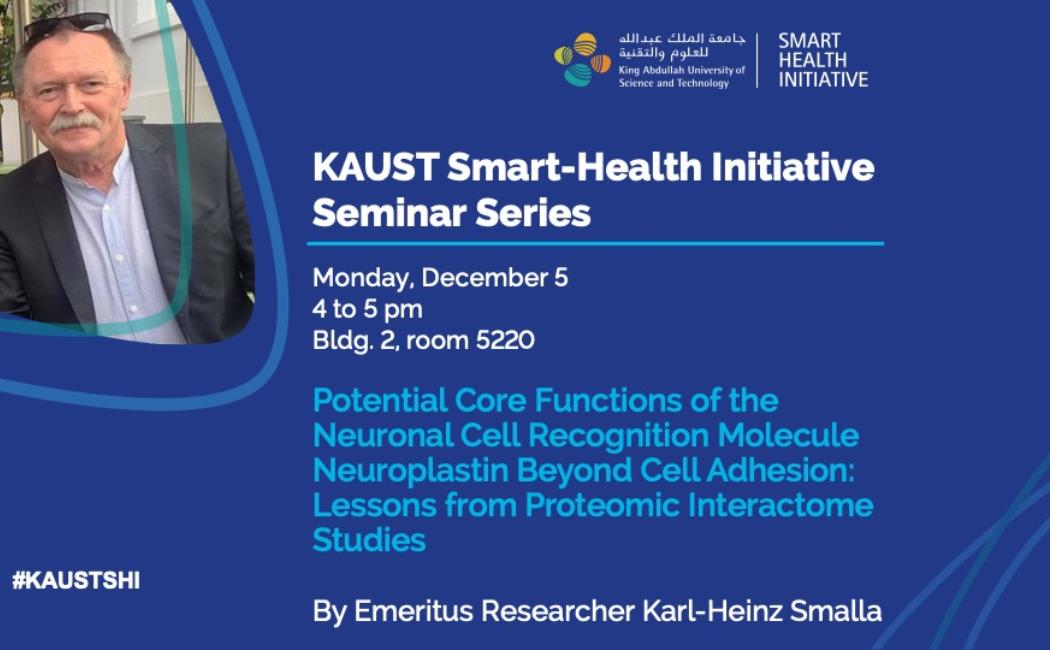
Potential Core Functions of the Neuronal Cell Recognition Molecule Neuroplastin Beyond Cell Adhesion: Lessons from Proteomic Interactome Studies
Please join us for the next KAUST Smart-Health Initiative (KSHI) seminar:
Potential Core Functions of the Neuronal Cell Recognition Molecule Neuroplastin Beyond Cell Adhesion: Lessons from Proteomic Interactome Studies
By Emeritus Researcher Karl-Heinz Smalla, the Leibniz Institute for Neurobiology (Germany) and The Institute for Pharmacology and Toxicology at Magdeburg University (Germany)
Abstract
Neuroplastin, a member of the Ig superfamily of cell adhesion molecules, has been implicated in neurophysiological and pathophysiological phenomena. Acute blockade of the synaptically enriched splice isoform Np65 interferes with maintenance of post-tetanic long-term potentiation and promotes mismatch of pre- and postsynaptic compartments. While single nucleotide polymorphisms in the human Neuroplastin gene have been linked to schizophrenia and intellectual ability, recent studies revealed severe learning deficits in mice with constitutive Neuroplastin knock-out. Moreover, retrograde amnesia was observed in mice when Neuroplastin was deleted after successful fear conditioning (Bhattacharya et al. (2017) Biol Psych 81; 124-135). To identify players involved in the physiological functions of Neuroplastin we performed a series of proteomic analyses on immuno-purified synaptic protein complexes containing Neuroplastin. Plasma membrane calcium ATPases (PMCAs) emerged as first order binding partners and this interaction is relevant beyond neurons (Korthals et al. (2017) Sci Reports 7, 8358; Herrera-Molina et al (2017) Sci Reports 7, 7273). In addition to PMCAs and previously described Neuroplastin-interacting proteins we identified some 40 additional proteins, which co-immunoprecipitated from wild-type forebrain synaptic junctional extracts but were absent from control precipitations from Neuroplastin knock-out mice. The identified proteins fall into several functional clusters including calcium homeostasis, transporters, vesicular proteins/exocytosis, regulatory proteins and cell surface proteins which points to pleiotropism of Neuroplastin in various cellular functions.
Although Neuroplastin has been reported to be present in presynaptic terminals, little is known about its role in presynaptic processes. To address this issue, we characterized presynaptic structure and function in primary hippocampal neurons derived from Np knockout mice. In Synaptotagmin antibody uptake assays we observed reduced synaptic vesicle cycling driven by endogenous network activity and after chemical depolarization, an effect that was rescued by overexpression of recombinant Np65- or Np55-GFP constructs. For a more detailed analysis, we used an ecliptic synaptopHluorin reporter to determine synaptic vesicle pools and release characteristics at individual synapses. This revealed that the readily-releasable pool (RRP) and total recycling pool (TRP) were reduced and the kinetics of exo/endocytosis were impaired in the absence of Neuroplastins.
Employing proteomic analyses and STED/Confocal microscopy we identified several proteins which co-precipitate/co-localize with Neuroplastin and are related to neurotransmitter release and synaptic vesicle recycling. Taken together, our results provide new insights into Neuroplastin functions at the presynapse.
About the speaker
Professor Karl-Heinz Smalla was born near Berlin in 1953. He studied physics at the Martin Luther University in Halle from 1974 to 1979. He completed his studies in 1979 with a diploma thesis in the field of solid-state physics. He then switched to physical chemistry at Halle University and completed his doctorate in liquid crystal research.
In 1983 he turned to neurobiology and has since worked at the Institute of Neurobiology and Brain Research and since 1992 at its successor, the Institute of Neurobiology in Magdeburg/Germany. There he was a member and later head of the Special Lab for Molecular Biological techniques. He became emeritus researcher in 2020 and remains active in ongoing projects.
His research focuses on
- Investigation of the molecular mechanisms underlying learning and memory formation or neuropathological diseases
- Proteomic approaches to the analysis of molecular changes in subcellular compartments with a focus on synaptic structures
- Neuronal cell adhesion molecules (especially Neuroplastins) and their role in neuroplasticity
- Molecular networks that build neuronal signalling pathways and synaptic protein interactions; contributions to improvement of the SynProt and SynGO databases of synaptic proteins
